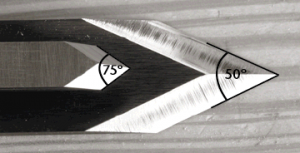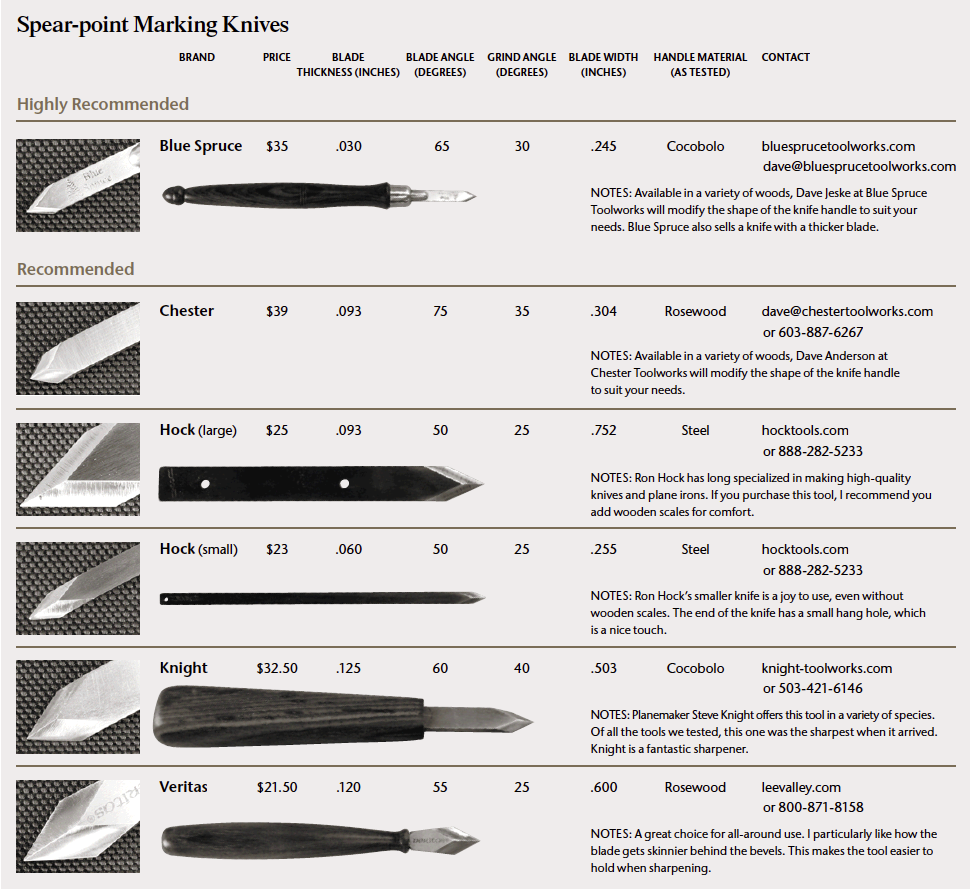We may receive a commission when you use our affiliate links. However, this does not impact our recommendations.
Versatile (but tricky to sharpen) – we help you select the best tool for your work.
From the March 2005 issue of Woodworking Magazine, pages 14-15

The Chester Toolworks knife has the largest angle at the tip (75°) while the Hock knife below it has the smallest angle (50°). The higher the angle, the more upright you hold the knife in use
Spear-point marking knives are the most versatile version of this invaluable marking tool. While other marking knives excel at one particular task, the spear-point varieties are good all-rounders and are an excellent first knife.
Unlike knives with a single bevel, the spear-point knife easily registers against a guide on either the knife’s left or right side. This is an important feature when marking dovetails. If you want to mark a dovetail with a single-bevel knife, you’re going to need two tools – a left and a right. I prefer the convenience of one tool.
Or, if you own a tool that has a knife-like edge (such as an X-acto or a pocketknife), you need to rotate the knife left or right depending on the mark you want to make. Learning to rotate the knife is a learnable skill. But more significantly, rotating the knife limits how tight a space you get the tool into. With a thin spear-point knife, you can sneak into almost any space.
I own many marking knives, including several I’ve made myself. So I know that the spear-point knife isn’t perfect for every operation. But once you get comfortable with a good spear-point tool, you’ll see your accuracy increase. And then you’ll realize how other knives can help your particular brand of woodworking.
A Boutique Selection
There are a lot of spear-point marking knives out there, and they are surprisingly different in the details. For this review, I’ve chosen six knives that are well-made and well-priced (some Japanese knives cost almost $100). Three of these knives are made by individual makers: the knives from Blue Spruce, Chester and Knight toolworks. The knives from Hock Tools come from a small company in Northern California. And the Veritas knife is from the largest hand-tool company in North America: Lee Valley Tools. Despite the company’s size, it maintains a personal touch.
For me, marking knives are an item of some intimacy, and so I gravitate toward tools made by people you can call on the phone and talk to personally. After six months of shop time, I can say that I like all of these knives, though each has quirks and limitations. This review should help you sort out the best one for you.
Three Important Characteristics
I don’t worry much about edge retention with these tools. Instead, here are the characteristics I have found to be more important:
■ Ergonomics: A marking knife must be comfortable in a variety of positions. It must be balanced, lightweight and keep your fingertips away from the sharp edges. You should be able to control the knife without a death grip.
■ Blade Angle: This is the angle of the spear point. Larger angles (such as the 75° tip of the Chester Toolworks knife) make a better line when the tool is nearly upright to the work. Smaller angles (such as the 50° tip of the Hock knives) cut better when pitched lower. This is an important difference. Larger blade angles are better for marking dados and tenons using a square because you want to deeply score both the near and far corners of your work to make it easy to carry the line around the workpiece. A larger blade angle cuts these corner marks without you having to radically angle your wrist.
I prefer the smaller-angle knives for dovetails, especially for transferring marks from the tail boards to the pin boards. The lower blade angle allows you to exert pressure in the right place.
■ Blade Thickness: If you make (or plan to make) closely spaced dovetails, this is an important feature. Thin knives allow you to sneak into tight spaces between the tails to mark out the pins. This benefit comes at a high price, however. Thin knives are more difficult to sharpen because the cutting bevels are considerably smaller.
About the Knives
After six months of use in our shop, here are my impressions and conclusions:
■ Blue Spruce Toolworks: This tool is the best choice for woodworkers who hand-cut dovetails. The thin blade is reinforced by two brass ferrules, which make it rigid. The middling blade angle makes it suited for both dovetail or bench work. And the tool is well-balanced, comfortable and a joy to wield. I even like the acorn on the end of the handle. Its only drawback is that its thin blade makes it the most difficult to sharpen.
■ Chester Toolworks: Though this tool looks a lot like the Blue Spruce tool, it’s actually quite different. The large blade angle makes it well suited for bench work; marking tenons, dados and anything else across the grain was a breeze for this tool. It’s not going to sneak into tight tails however; it’s three times thicker than the Blue Spruce knife. The handle isn’t quite as comfortable as the one on the Blue Spruce tool, but the tool does a high-quality job overall. The ease of sharpening ranks somewhere in the middle.
■ Hock Tools, large knife: Sold without a wooden handle or scales, this tool is begging for some customization from its owner. The low blade angle (50°) allows the tool to cut well while the tool is nearly parallel to the bench, though the blade’s thickness limits the type of dovetails you can mark out. It and the Veritas were the easiest to sharpen because the blades of both are thick and wide with large bevels. Unlike the other tools in this test, both Hock knives required significant setup. All the backs had to be lapped flat and polished, and the bevels had to be ground and honed. Luckily, this particular blade was heat treated well so there was little warping.
■ Hock Tools, small knife: Though this tool was also sold without a handle, it fits easily in the hand as-is, like a pencil. It’s a little thinner and considerably narrower than the larger Hock knife. This makes it ideal for sneaking into tight places, though not as well as the thinnest tool, the Blue Spruce. Like its larger cousin, this tool needed significant setup. Annoyingly, the tip of the tool was a bit warped, which resulted in a lot of lapping. Once I got the tool working, however, it performed well.
■ Knight Toolworks: The Knight marking knife has a chunky handle that isn’t particularly comfortable when held in a pencil-like fashion. Specifically, I wish the thick back end of the knife were thinner, which would make it more comfortable for marking dovetails. The middling blade angle allowed it to cut well in upright or down-low positions, and the thick blade made it an easy tool to sharpen (though it was impossible to navigate the knife into tight tail joints). If the handle were thinner, this would be a good knife for marking out joints.
■ Veritas: While the large bevels of this tool make it easy to keep sharp, I have some concerns about the handle. Overall, the shape of the handle is comfortable and its flats keep it from rolling off your bench. But the handle’s factory finish was rough. I sanded it off, took the wood to #400 grit and applied a better finish. Also, the bead on the handle was vulnerable to damage; ours became chipped after two months of use. The blade angle makes it well suited for dovetailing, though its thickness prevented it from sneaking into the narrowest dovetails. However, the tool’s price makes it a good value. It is the least expensive knife and performs admirably.
Conclusions
Overall, my hands concluded that the Blue Spruce knife was the right tool for my style of work. That shouldn’t be surprising. I cut a lot of dovetails, do quite a bit of bench work and I’m an experienced sharpener. When not cutting dovetails, I tended to favor the Chester and the (modified) Veritas knife.
Here are some supplies and tools we find essential in our everyday work around the shop. We may receive a commission from sales referred by our links; however, we have carefully selected these products for their usefulness and quality.









